外研版(2019) 必修 第三册 Unit 4 Amazing art Reading课件(共33张PPT)
文档属性
| 名称 | 外研版(2019) 必修 第三册 Unit 4 Amazing art Reading课件(共33张PPT) |

|
|
| 格式 | zip | ||
| 文件大小 | 12.0MB | ||
| 资源类型 | 教案 | ||
| 版本资源 | 外研版(2019) | ||
| 科目 | 英语 | ||
| 更新时间 | 2023-03-12 11:47:43 | ||
图片预览

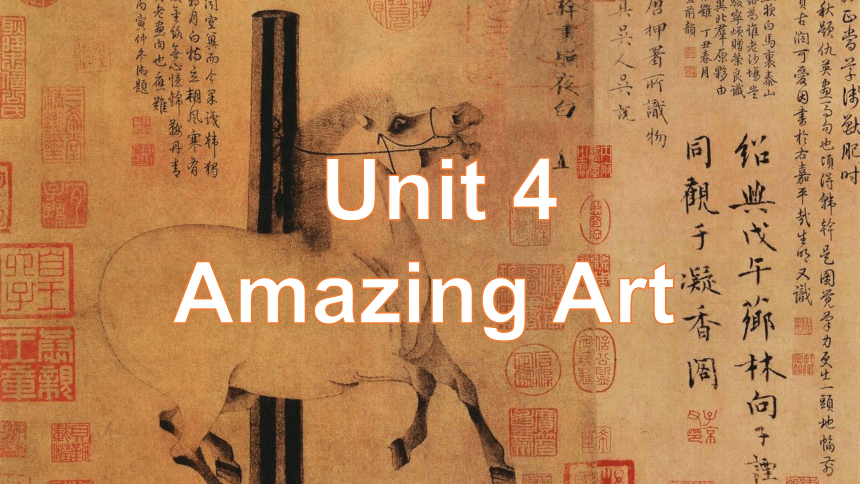



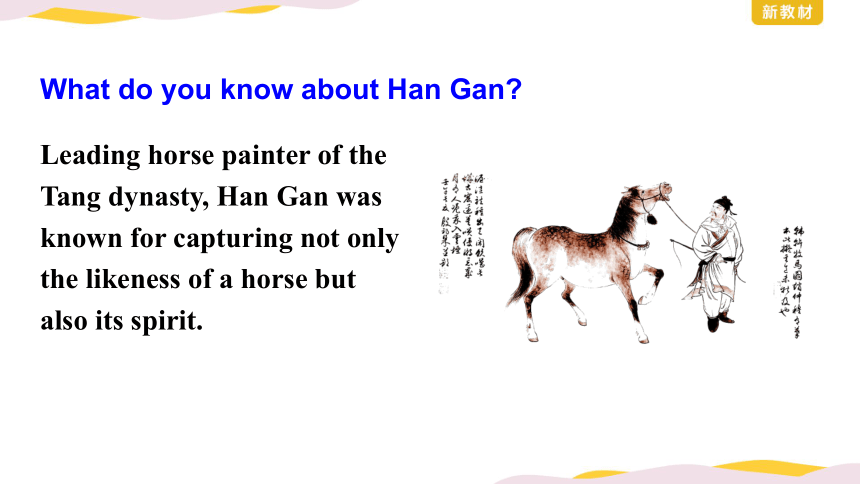
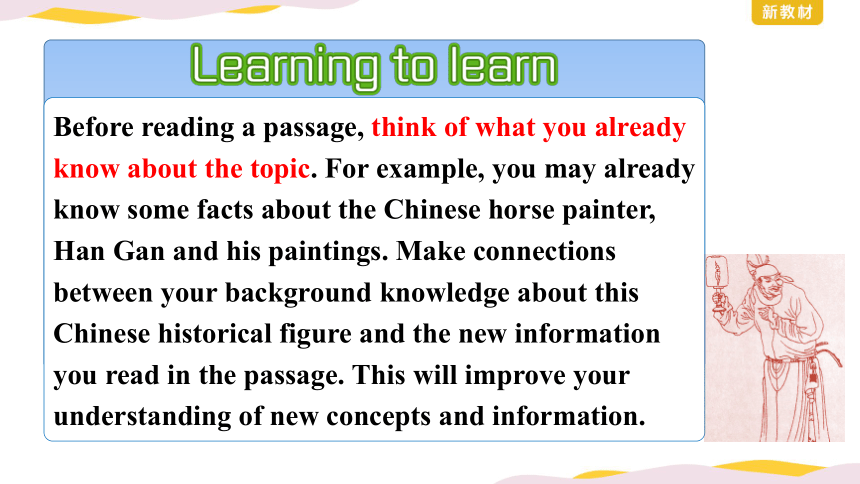

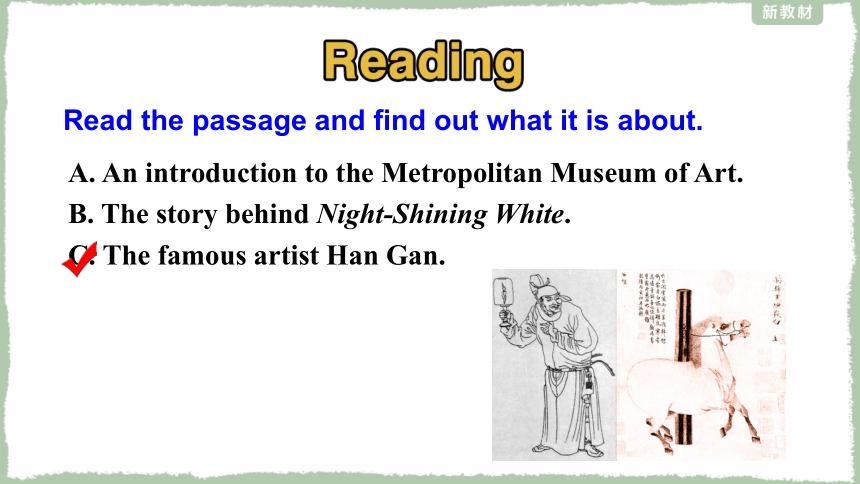
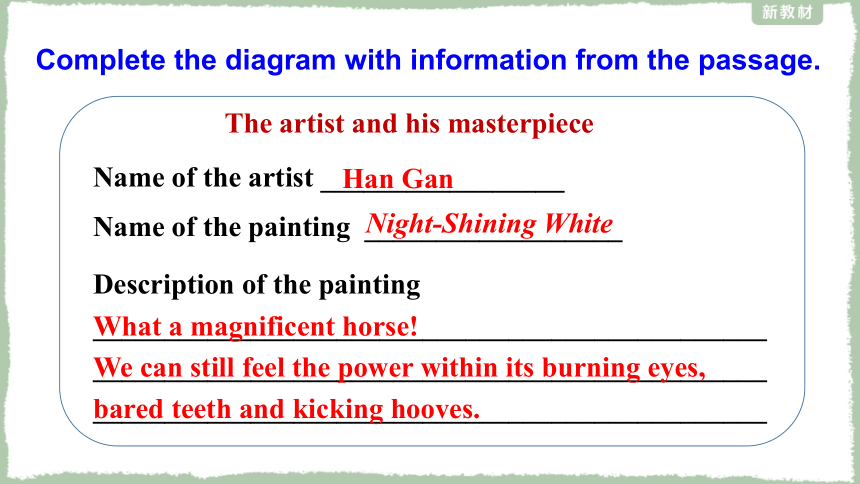
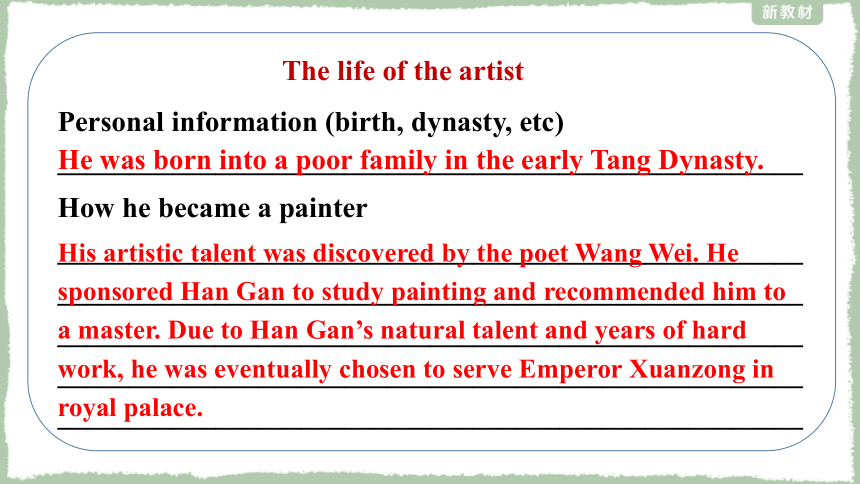
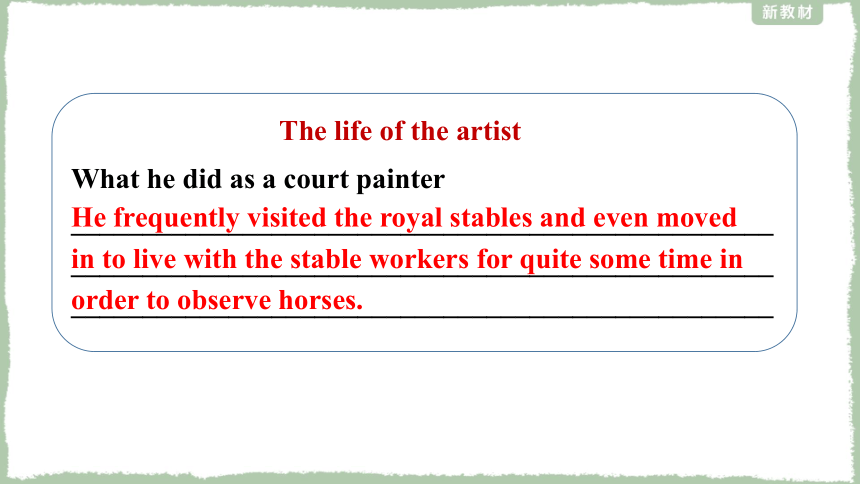
文档简介
(共33张PPT)
Unit 4
Unit 4
Amazing Art
1. To read to know something about the life and paintings of Han Gan.
2. To talk about what you think of Han Gan.
3. To learn some words and expressions.
Tick the words that you would use to describe horses. Add any more you can think of.
□ calm
□ brave
□ cute
□ clever
□ loyal
□ fast
□ wild
□ strong
Now compare your choices with the rest of the class and share what you know about horses.
What do you know about Han Gan
Leading horse painter of the Tang dynasty, Han Gan was known for capturing not only the likeness of a horse but also its spirit.
Before reading a passage, think of what you already know about the topic. For example, you may already know some facts about the Chinese horse painter, Han Gan and his paintings. Make connections between your background knowledge about this Chinese historical figure and the new information you read in the passage. This will improve your understanding of new concepts and information.
首先,在阅读之前可利用所知道的关于韩干及其画作《照夜白图》的知识,通过文章的标题对文本内容作出预测,如文本将如何展开叙述,文章可能会介绍哪些方面的内容等。
接着,带着已有的背景知识和疑问进行阅读,与新信息进行对比,加深并内化新信息。这不仅有助于对韩干的生平、创作风格、艺术造诣、后人评价有更加深入的理解,也有助于汲取我国的艺术文化精髓、培养良好的鉴赏能力。
利用背景知识辅助理解文本
Read the passage and find out what it is about.
A. An introduction to the Metropolitan Museum of Art.
B. The story behind Night-Shining White.
C. The famous artist Han Gan.
Complete the diagram with information from the passage.
The artist and his masterpiece
Name of the artist _________________
Han Gan
Name of the painting __________________
Night-Shining White
Description of the painting
_____________________________________________________________________________________________________________________________________________
What a magnificent horse!
We can still feel the power within its burning eyes, bared teeth and kicking hooves.
The life of the artist
Personal information (birth, dynasty, etc)
____________________________________________________
He was born into a poor family in the early Tang Dynasty.
How he became a painter
____________________________________________________
____________________________________________________
____________________________________________________
____________________________________________________
____________________________________________________
His artistic talent was discovered by the poet Wang Wei. He sponsored Han Gan to study painting and recommended him to a master. Due to Han Gan’s natural talent and years of hard work, he was eventually chosen to serve Emperor Xuanzong in royal palace.
What he did as a court painter
_________________________________________________
_________________________________________________
_________________________________________________
He frequently visited the royal stables and even moved in to live with the stable workers for quite some time in order to observe horses.
The life of the artist
Comments on his work
Su Shi
___________________________
___________________________
“The horses painted by Han Gan are real horses.”
Other viewers
____________________________________________________
Han Gan’s horses “could gallop off the paper”.
少陵翰墨无形画,韩干丹青不语诗。
此画此诗真已矣,人间驽骥漫争驰。
1. What made Han Gan a successful painter
His natural talent, years of hard work and his unique method.
It means that the horses painted by Han Gan look like real horses due to his talent, skill and careful observation.
2. What does Su Shi’s comment mean to you
Observe something carefully.
Stick to one thing / put one’s heart into something.
…
3. What can you learn from Han Gan’s way of painting
4. Do you know of any other artists famous for painting animals Introduce one to the class.
The famous painter Xu Beihong was also well-known for his horse painting. He was born in contemporary China, and had studied overseas. Not only did he do well in horse painting, he was also good at painting flowers, birds and people.
Night-Shining White, which is regarded (1) ______ one of the most important horse (2) __________ (paint) in the history of Chinese art, was painted by a (3) ________ (talent) artist— Han Gan. He is (4) _______ (know) for his unique skill in capturing the physical and inner features of the animal. When he was a child, he had to support his family by (5) _______ (work) in a wine shop. One day, his talent was
as
paintings
talented
working
known
Complete the summary. Some words are given. Change the form when necessary.
discovered by the poet Wang Wei, who decided (6) _________ (sponsor) the young man. After years of hard work, Han Gan was chosen to serve Emperor Xuanzong (7) _________ (eventual).
The Tang emperors were very fond (8) _______ horses, so many artists chose the animal as the subject. The reason (9) ________ his paintings are different is that he spent much time observing the horses for (10) __________ (inspire). Till now, his paintings have won a good fame all over the world.
eventually
to sponsor
of
inspiration
why
Work in groups. Imagine you are a tour guide in the Metropolitan Museum of Art. Use the information in Activity 3 to talk about the life and work of Han Gan.
1. Think about what information to include.
2. Decide in what order you will introduce.
3. Introduce Han Gan and his painting to your group members.
1. Night-Shining White, now kept in New York’s Metropolitan Museum of Art, is regarded as one of the most significant
horse paintings in the history of Chinese art.
现收藏于纽约大都会艺术博物馆,《照夜白图》 被认为是中国艺术史上最重要的骏马图之一。
Night-Shining White is a portrait, and the name, of a favorite horse of Emperor Xuanzong (r.712-756). The painting is 34 cm wide by 30.8 cm high. Delicate and precise, it is an example of “baihua”(or “white painting”), a term used in Tang texts to describe monochrome (黑白的) painting with ink shading, as opposed to full colour painting.
Over the years, many seals and inscriptions have been added to the painting and its borders by its owners. Being a distinctive mark of Chinese art collecting, these serve as a record of the work’s journey through history and the impression it has left upon each generation.
2. His artistic talent was discovered by accident when he was sent to the poet Wang Wei’s house to collect payment for some wine.
他被派到诗人王维家里去收酒钱,王维无意中发现了他的艺术才华。
by accident: by chance; in a way that is not planned or intended 偶然,意外地
eg The basement caught fire by accident.
3. While waiting at the gate, Han Gan used a stick to draw pictures in the dirt and was seen by the poet himself.
当时,韩干在门口等候,他捡起一根木棒在土地上画画,正好被王维看到。
while引导省略的时间状语从句
poet的同位语
本句中,himself作了poet的同位语。第三段中也有一个反身代词作同位语,请找出来。
Han Gan’s method, however, was different— he observed the animal itself.
4. The Tang emperors were very fond of horses.
唐朝的皇帝非常喜欢马。
be fond of+ n./ v.–ing/ pron. 喜欢……,爱好……
eg She is fond of animals of all kinds, such as the dog and the cat.
I’m not very fond of cooking.
Over the years, I have grown quite fond of her.
5. Day after day, Han Gan painted the horses, his brush presenting every detail that he saw with his own eyes.
his brush presenting…是一个独立主格结构,his brush是现在分词presenting的逻辑主语。
句意:韩干日复一日地练习画马,用画笔把眼睛观察到的每一处细节都呈现出来。
时间状语
that引导的定语从句,修饰every detail
day after day: Continuously for a long time in a way that is
annoying or boring =day in day out 日复一日,天天地
eg I couldn’t stand sitting at a desk day after day.
我忍受不了日复一日地坐在办公桌前。
Day after day passed by without a line from him.
一天天过去了,没有他的一点消息。
day by day: slowly and gradually 天天,逐日,渐渐地
eg Her health was improving day by day.
【语境应用】选词填空(day after day/ day by day)
1) They plant trees ___________ and the trees are
growing taller ___________.
2) ___________, week after week and month after month,
they worked on.
day after day
day by day
Day after day
6. All the horses in your stables are my very teachers.
您马厩里所有的马正是我的老师。
very used to emphasize that you are talking exactly about one particular thing or person adj. (用于加强语气)正是那一个的,正是的
eg Those were his very words. 那就是他的原话。
His life’s work was being destroyed before his very eyes (=directly in front of him) .
他毕生的成果就在他的眼前被人糟蹋。
7. Those who saw Han Gan’s horse paintings all sang high praises for his unique skill, saying that his horses “could gallop off the paper”.
句意:看过韩干的的骏马图的人都对他独特的技艺赞赏有加,称他的马“跃然纸上”。
who引导的定语从句
现在分词短语作状语
sing high praises for to speak very highly of something or someone; to enthusiastically endorse someone or something
高度赞扬
eg We all sing high praises for Zhong Nanshan, who makes great contributions to the treatment of the disease.
我们都高度赞扬钟南山,他为治疗这种疾病做出了巨大贡献。
同义表达
think highly of, speak highly of, have a high opinion of
【语境应用】一句多译。
他们对这部电影评价很高。
They sing high praises for the movie.
They think highly of the movie.
They have a high opinion of the movie.
Read the passage again and make a profile (人物简介) about Han Gan. You can surf the Internet for more information if necessary.
Unit 4
Unit 4
Amazing Art
1. To read to know something about the life and paintings of Han Gan.
2. To talk about what you think of Han Gan.
3. To learn some words and expressions.
Tick the words that you would use to describe horses. Add any more you can think of.
□ calm
□ brave
□ cute
□ clever
□ loyal
□ fast
□ wild
□ strong
Now compare your choices with the rest of the class and share what you know about horses.
What do you know about Han Gan
Leading horse painter of the Tang dynasty, Han Gan was known for capturing not only the likeness of a horse but also its spirit.
Before reading a passage, think of what you already know about the topic. For example, you may already know some facts about the Chinese horse painter, Han Gan and his paintings. Make connections between your background knowledge about this Chinese historical figure and the new information you read in the passage. This will improve your understanding of new concepts and information.
首先,在阅读之前可利用所知道的关于韩干及其画作《照夜白图》的知识,通过文章的标题对文本内容作出预测,如文本将如何展开叙述,文章可能会介绍哪些方面的内容等。
接着,带着已有的背景知识和疑问进行阅读,与新信息进行对比,加深并内化新信息。这不仅有助于对韩干的生平、创作风格、艺术造诣、后人评价有更加深入的理解,也有助于汲取我国的艺术文化精髓、培养良好的鉴赏能力。
利用背景知识辅助理解文本
Read the passage and find out what it is about.
A. An introduction to the Metropolitan Museum of Art.
B. The story behind Night-Shining White.
C. The famous artist Han Gan.
Complete the diagram with information from the passage.
The artist and his masterpiece
Name of the artist _________________
Han Gan
Name of the painting __________________
Night-Shining White
Description of the painting
_____________________________________________________________________________________________________________________________________________
What a magnificent horse!
We can still feel the power within its burning eyes, bared teeth and kicking hooves.
The life of the artist
Personal information (birth, dynasty, etc)
____________________________________________________
He was born into a poor family in the early Tang Dynasty.
How he became a painter
____________________________________________________
____________________________________________________
____________________________________________________
____________________________________________________
____________________________________________________
His artistic talent was discovered by the poet Wang Wei. He sponsored Han Gan to study painting and recommended him to a master. Due to Han Gan’s natural talent and years of hard work, he was eventually chosen to serve Emperor Xuanzong in royal palace.
What he did as a court painter
_________________________________________________
_________________________________________________
_________________________________________________
He frequently visited the royal stables and even moved in to live with the stable workers for quite some time in order to observe horses.
The life of the artist
Comments on his work
Su Shi
___________________________
___________________________
“The horses painted by Han Gan are real horses.”
Other viewers
____________________________________________________
Han Gan’s horses “could gallop off the paper”.
少陵翰墨无形画,韩干丹青不语诗。
此画此诗真已矣,人间驽骥漫争驰。
1. What made Han Gan a successful painter
His natural talent, years of hard work and his unique method.
It means that the horses painted by Han Gan look like real horses due to his talent, skill and careful observation.
2. What does Su Shi’s comment mean to you
Observe something carefully.
Stick to one thing / put one’s heart into something.
…
3. What can you learn from Han Gan’s way of painting
4. Do you know of any other artists famous for painting animals Introduce one to the class.
The famous painter Xu Beihong was also well-known for his horse painting. He was born in contemporary China, and had studied overseas. Not only did he do well in horse painting, he was also good at painting flowers, birds and people.
Night-Shining White, which is regarded (1) ______ one of the most important horse (2) __________ (paint) in the history of Chinese art, was painted by a (3) ________ (talent) artist— Han Gan. He is (4) _______ (know) for his unique skill in capturing the physical and inner features of the animal. When he was a child, he had to support his family by (5) _______ (work) in a wine shop. One day, his talent was
as
paintings
talented
working
known
Complete the summary. Some words are given. Change the form when necessary.
discovered by the poet Wang Wei, who decided (6) _________ (sponsor) the young man. After years of hard work, Han Gan was chosen to serve Emperor Xuanzong (7) _________ (eventual).
The Tang emperors were very fond (8) _______ horses, so many artists chose the animal as the subject. The reason (9) ________ his paintings are different is that he spent much time observing the horses for (10) __________ (inspire). Till now, his paintings have won a good fame all over the world.
eventually
to sponsor
of
inspiration
why
Work in groups. Imagine you are a tour guide in the Metropolitan Museum of Art. Use the information in Activity 3 to talk about the life and work of Han Gan.
1. Think about what information to include.
2. Decide in what order you will introduce.
3. Introduce Han Gan and his painting to your group members.
1. Night-Shining White, now kept in New York’s Metropolitan Museum of Art, is regarded as one of the most significant
horse paintings in the history of Chinese art.
现收藏于纽约大都会艺术博物馆,《照夜白图》 被认为是中国艺术史上最重要的骏马图之一。
Night-Shining White is a portrait, and the name, of a favorite horse of Emperor Xuanzong (r.712-756). The painting is 34 cm wide by 30.8 cm high. Delicate and precise, it is an example of “baihua”(or “white painting”), a term used in Tang texts to describe monochrome (黑白的) painting with ink shading, as opposed to full colour painting.
Over the years, many seals and inscriptions have been added to the painting and its borders by its owners. Being a distinctive mark of Chinese art collecting, these serve as a record of the work’s journey through history and the impression it has left upon each generation.
2. His artistic talent was discovered by accident when he was sent to the poet Wang Wei’s house to collect payment for some wine.
他被派到诗人王维家里去收酒钱,王维无意中发现了他的艺术才华。
by accident: by chance; in a way that is not planned or intended 偶然,意外地
eg The basement caught fire by accident.
3. While waiting at the gate, Han Gan used a stick to draw pictures in the dirt and was seen by the poet himself.
当时,韩干在门口等候,他捡起一根木棒在土地上画画,正好被王维看到。
while引导省略的时间状语从句
poet的同位语
本句中,himself作了poet的同位语。第三段中也有一个反身代词作同位语,请找出来。
Han Gan’s method, however, was different— he observed the animal itself.
4. The Tang emperors were very fond of horses.
唐朝的皇帝非常喜欢马。
be fond of+ n./ v.–ing/ pron. 喜欢……,爱好……
eg She is fond of animals of all kinds, such as the dog and the cat.
I’m not very fond of cooking.
Over the years, I have grown quite fond of her.
5. Day after day, Han Gan painted the horses, his brush presenting every detail that he saw with his own eyes.
his brush presenting…是一个独立主格结构,his brush是现在分词presenting的逻辑主语。
句意:韩干日复一日地练习画马,用画笔把眼睛观察到的每一处细节都呈现出来。
时间状语
that引导的定语从句,修饰every detail
day after day: Continuously for a long time in a way that is
annoying or boring =day in day out 日复一日,天天地
eg I couldn’t stand sitting at a desk day after day.
我忍受不了日复一日地坐在办公桌前。
Day after day passed by without a line from him.
一天天过去了,没有他的一点消息。
day by day: slowly and gradually 天天,逐日,渐渐地
eg Her health was improving day by day.
【语境应用】选词填空(day after day/ day by day)
1) They plant trees ___________ and the trees are
growing taller ___________.
2) ___________, week after week and month after month,
they worked on.
day after day
day by day
Day after day
6. All the horses in your stables are my very teachers.
您马厩里所有的马正是我的老师。
very used to emphasize that you are talking exactly about one particular thing or person adj. (用于加强语气)正是那一个的,正是的
eg Those were his very words. 那就是他的原话。
His life’s work was being destroyed before his very eyes (=directly in front of him) .
他毕生的成果就在他的眼前被人糟蹋。
7. Those who saw Han Gan’s horse paintings all sang high praises for his unique skill, saying that his horses “could gallop off the paper”.
句意:看过韩干的的骏马图的人都对他独特的技艺赞赏有加,称他的马“跃然纸上”。
who引导的定语从句
现在分词短语作状语
sing high praises for to speak very highly of something or someone; to enthusiastically endorse someone or something
高度赞扬
eg We all sing high praises for Zhong Nanshan, who makes great contributions to the treatment of the disease.
我们都高度赞扬钟南山,他为治疗这种疾病做出了巨大贡献。
同义表达
think highly of, speak highly of, have a high opinion of
【语境应用】一句多译。
他们对这部电影评价很高。
They sing high praises for the movie.
They think highly of the movie.
They have a high opinion of the movie.
Read the passage again and make a profile (人物简介) about Han Gan. You can surf the Internet for more information if necessary.
